Ruth Knafo Setton's Blog, page 3
August 2, 2016
The Art of the Writers Residency
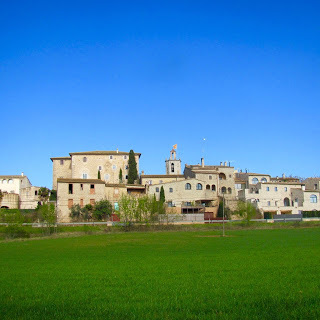 Rocaberti Castle
Rocaberti CastleI've been to many writers residencies, and in fact, I'm looking forward to returning in late September to the wonderful Virginia Center for the Creative Arts. A writers residency can offer the priceless gifts of time and space to create, but it definitely helps to know how to prepare for one, and my friend Georgia Clark offers helpful tips below. Take it away, Georgia!
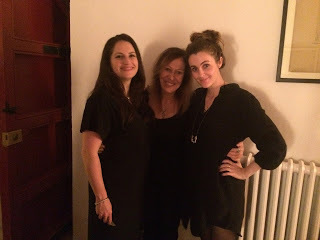
Abby Rodriguez, Georgia & me at Rocaberti
By Georgia Clark
Ruth and I met in a 14thcentury Spanish castle, a few hours north of Barcelona, on my sixth writers’ residency. I’d never been on a residency before moving from Sydney to New York, and stumbled across my first one (the wonderful What the hell’s a writer’s residency?An organized time and space for writers to work. Some are free, some cost money. (The free ones are generally the most competitive). Some include meals, some include one meal, some have a space for you to cook. Some are structured (our Spanish residency included time with a mentor), most are not. Some will be life-changing. All exemplify the adage ‘you get out what you put in’. They exist because writing is hard, community is important, people are generous, and hey—who doesn’t want to spend a few weeks somewhere gorgeous, bashing away in a room of one’s own?
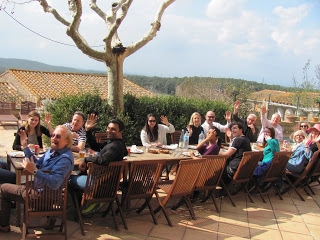
How do I get in?The application for a residency can be a lot of work (possibly including a writers resume, sample, outline of intended work and references), but once you’ve done one you can pretty much repurpose it for other residencies. Be as human and engaging in your project pitch as possible: explain why the work matters to you and what you’re about, really. Don’t be too formal. The magic of a good residency is about artists who think and feel, not business people who have perfect CVs. Overwhelmed by choice? Narrow it down to ones you can travel easily to, ones friends recommend (and might be a reference for; this helps), ones you can afford.
Find your ideal residency at Res Artis, Poets & Writers, Artist Communities or random Googling.
What do I prepare?Great question, Georgia. Even though most writers’ residencies are self-directed, it’s a great idea to mentally and physically prepare for them. Decide well in advance what you’ll be working on, and set the bar high for yourself. At my last Martha’s Vineyard residency, I committed to writing the outline for my next novel, which was a big, unwieldy task that would’ve taken me three times at long in my usual, distraction-heavy environment. At the Obras residency in rural Portugal, I made the mistake of assuming I was there to polish what I thought was an almost-completed novel, only to hear back from my editor on Day 1 that is was an “okay” first draft. I wasn’t prepared for that and consequently spent a lot of time crying into large glasses of admittedly excellent port.
Alternatively, you might be on residency to relax and find inspiration: long solo walks, time away from the kids, etc. Again, set some goals for this: maybe you’ll commit to finding three great ideas for your next project.
Tips on having a great residency! · Join your fellow writers for at least one meal a day, ideally dinner. It’s a great way to take a break and make real connections. Pair up and take turns cooking meals.· Bring sleep aids and exercise gear. You’ll be mentally exhausted but not physically which can make it hard to sleep. · Disconnect from the outside world. Set up a vacation email and manage loved ones’ expectations of contact. Once phone call a day is fine, constant texting is not really the point. · Don’t worry about anyone else’s work. It can be easy to feel annoyed or jealous at how much or little other writers are doing or have achieved in their careers. Let it go. This is about you.· Know that there will be at least one crazy person. Give them a wide berth. Don’t get involved in drama; just enjoying gossiping about. · See something special as a group. To make it especially memorable, plan a group outing to see a local landmark/museum/bar. Being a good writer means having a good community.
Have fun! I’ve met wonderful people from all around the world in residencies; they really are one of the most fun parts about being a creative.
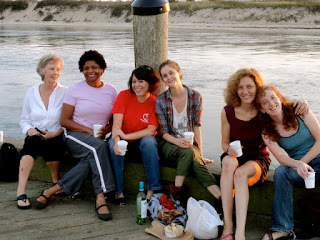
Share your tips, stories and advice about residencies in the comments below!
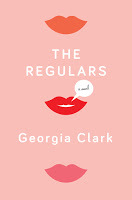 Georgia Clark is the author of THE REGULARS, forthcoming from Emily Bestler Books/Atria in August 2016. Follow her on Instagram and Twitter at @georgialouclark. Sign up for monthly writing tips at georgiaclark.com
Georgia Clark is the author of THE REGULARS, forthcoming from Emily Bestler Books/Atria in August 2016. Follow her on Instagram and Twitter at @georgialouclark. Sign up for monthly writing tips at georgiaclark.com
Published on August 02, 2016 05:31
July 19, 2016
Packing Heat: Writing the Sex Scene

If you've been struggling with writing scenes of desire, eroticism, and sex, you're not the only one!
In today's post, my friend, talented writer, Katherine Ramsland, shares her journey into writing the sex scene. Take it away, Katherine!
Many of us who write fiction face decisions about how to portray erotically charged scenes, especially those involving sex. The decisions are fraught with personal issues:
Will my mother read this?
Will readers think this is what I like?
Will anyone but me think this is hot?
Those scenes that succeed for me might say something about me, but they also affirm word choice, delivery, and the ability to pull me into the characters. So, there’s a lot to build before you get to the sex act. Sensuality can be achieved in many ways, and we probably won’t succeed universally, since sex is so personal. But whether sex is important to a plot or just an enticing sideline, we must figure out our approach.
I’ve read novels that start with characters coupling. Because I don’t know them, the scene falls flat. I’ve also read novels where no matter how much the sex partners grind and bounce and beg, the scene lacks energy. This means it lacks credibility. And I want to skip over such scenes.
Unless you’re just writing porn, you need to make readers care. ElizabethCratty, who wrote How to Write a Sizzling Sex Scene, says that emotional intensity is the key to making sex scenes pop. This means longing, a sense of connection, and vulnerability. “When you’re writing a sex scene,” she says, “both parties bring to the union their entire histories.”
There are no formulas. Some authors bring characters right up to the moment of unclothing and then cut away. Others are highly graphic. Some use clinical words; others think you should never do that.
Go on any blog that gives advice about how to write a sex scene and then read through the comments. They will range from “thank you, this really helps” to “you’re so wrong. My sex scenes use blah, blah, blah…” I once read a novel in which a specific image had a strong impact. It kept coming back to me as the hottest moment in the book. To my surprise, the author said that if she could do it over, she wouldn’t use that image. So, who really knows?
I’ve seen advice that we should do only what feels comfortable to us. By putting our character in motion, we discover our boundaries. But here’s the thing: I cut my teeth on the multiple drafts of D. H. Lawrence’s Lady Chatterly’s Lover, some of which were shockingly crude to a teenage girl. I’ve read the Marquis de Sade books, I wrote a companion to Anne Rice’s erotica, and I’ve written nonfiction about all kinds of BDSM, including the kinky sex of necrophiles. But I still find it difficult to decide how much I want to describe in a sex scene in my fiction.
I can imagine it all, but I find that packing heat into words diminishes the impact. So, am I just not finding the right words or the right ways to string them together?
For me, the kind of embodied emotion that draws characters together is an intensity that keeps growing, with the hint that they will become more. It’s a force that they struggle against but also facilitate in a way that triggers conflicted feelings. Eventually, the craving becomes too strong to block. It’s a raw, commanding force that undermines the characters’ calculations but still gets them to their goals.
My novel, The Ripper Letter, inevitably involves sex, because the core of my supernatural universe is erotic. My protagonist, a female detective named Dianysus, finds a divination device that works best with sexual energy. To get the goods she must work herself up. She creates a fantasy figure, but shestill must turn all the dials.
I was going to include a scene here to illustrate what I mean, but it doesn’t work. I could tell you how she slid her fingers down the curve of her side, and how her breath shortened and heartbeat increased as heat flushed through her. Or her first impression of the character with whom she will eventually entangle. But taking these scenes out of context is like deflating a balloon. If you don’t know her, you won’t feel her.
So, I think that a good sex scene is not necessarily about the words. It’s about emotional rhythms that play covertly in the background. We need to figure out how to fuel this while also guiding the overt plot. When Dianysus does have her “entanglement,” it happens at a time, in a place, and for reasons that surprise her, and yet the thrust of energy that propels her has been there all along. That’s what makes it work. (I think.)
How do we accomplish this? Whether we outline or write more spontaneously, I think we must remain alert to multiple layers of emotion. This will arise from our character development, so creating character profiles, with motivations, goals, and flaws, is part of the process. This means focusing on what they desire, how they deal with being thwarted, how this changes them, and how it impacts their momentum.
Writing dynamic sex scenes could be similar to the fluid genius of good improvisation. An NIH-funded f-MRI study on jazz musicians revealed that when they played their extraordinary riffs, the part of the prefrontal cortex that engages self-awareness shut down: the musicians lost their internal censors and moved boldly into the music.
“It’s a remarkable frame of mind,” says Johns Hopkins researcher Charles Limb, “during which, all of a sudden, the musician is generating music that has never been heard, thought, practiced or played before. What comes out is completely spontaneous. What we think is happening is when you’re telling your own musical story, you’re shutting down impulses that might impede the flow of novel ideas.”
Writing a memorable sex scene needs more improv than formula, more exploration of the titillating unknown. Still, we also know that improv experts have generally practiced for many, many hours. They know their instruments and methods so well that they can totally indulge. They can enter what psychologist Mihaly Csikszentmihalyi calls the state of flow. This is a complete absorption in a given activity that produces a sense of effortless concentration. The moment is exciting and alive, inwardly attuned. We are one with the work.
Becoming good at writing sex scenes might involve such uncensored focus. So, like musicians who know all their notes, it might help to make a list of the sensual and sexual words that appeal to you, and then bathe in them. Immerse. Get so familiar with them that when it’s time to work up some writing improv, you’re already intimately connected to the most useful words. You can choreograph your sex without having to think.
I think I’ll go try that now.
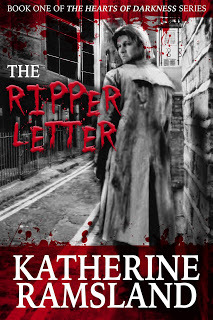
Katherine Ramsland has published 59 books. She teaches forensic psychology, is an expert on serial murder, and has personally explored the Ripper murder sites. www.katherineramsland.com
Published on July 19, 2016 06:58
July 7, 2016
The Sweetness of Doing Nothing

It was my thirteenth summer, and the livin' was easy.... My parents had planned no activities for me, no summer camp, no piano lessons. Each day was an eternity to be filled by my own desires. Eventually my bike led me to the pool or the library-- ah, that old high-ceilinged, sunny library, where I could explore freely, and sneak into the adult section, and pick whatever caught my eye: new and old, glittering titles, fairy tales and mysteries, travel books and biographies. I lay in my backyard and read for hours, and afterwards, closed my sun-dazed eyes and imagined myself traveling to exotic lands, and maybe even creating one of my own....
When it got dark, my friends and I played games and leaped after fireflies....
It was one of the best summers of my life.
I have a Mediterranean temperament-- work hard, play hard, and savor sleep, food, and sun. I write everyday, except those periods when I am forced to stop, either because of life's demands or because my mind and body tell me it's time to slow down.... To play with kids... to lie out back and read like I used to... to linger over lunch with friends... to walk in the park... It's time for me to be quiet. To gather words again, slowly and lovingly, the way I used to gather ripe berries with joy and wonder, eating them from the bush, dizzyingly sweet.... To catch words the way I used to catch fireflies-- a flash of light and heat between my palms-- and then, to release them.
I used to worry about losing words after I'd set them free, but then I remembered my grandfather on his rooftop in Morocco. He raised fifty homing pigeons in two enormous brass cages. He never locked the gates. He trusted they would return to him. They always did.
I had to trust that my words would eventually return, too. And they do. They know I'm on my own rooftop, waiting.
Sometimes I think we just have to trust in life, in its organic rhythms, to carry us where we need to be. And sometimes that place is right where we are at this moment.
The Italians have a delicious phrase for the art of doing nothing: Il dolce far niente .

The ancient sages of religions incorporated a day of rest in the weekly calendar. Farmers learned that fields cannot be harvested year after year without being given a season to lie fallow in order to renew and replenish. Humans are the same: we need time out from our increasingly regimented schedules.
Doing nothing is hard work, particularly when balancing our jobs and children, but if we can try to wrest a moment, an hour, a day from our busy lives, we find unexpected rewards.
So what can we do to increase our enjoyment of the art of doing nothing?
Get over the guilt. This is my personal challenge. Savor the moment. Be in the moment. Whatever you're doing, try to do it with all of you.That means putting the phone away for a moment. Look at who you're with. Look at your surroundings. Look at your food. Be here, now.You can also withdraw for a bit to dream and recharge. Enjoy a siesta... you don't have to sleep, but you can close your eyes....Read a book for pleasure. Actually, do something, anything-- garden, cook, draw, paint, play music-- for the sheer joy. No judgment, just for yourself and the people you love.Play. Borrow children if you don't have any and follow their rhythm. That means slowing down. If you've ever walked with a child, you know that the way to where you're going may have fascinating detours you never explored. When you have leisure time, try not to over-organize it. Leave time to be spontaneous.I find profound similarities between the Zen art of mindfulness and the art of doing nothing. They're all about living in the moment, as much as you can.
‘Drink your tea slowly and reverently, as if it is the axison which the world earth revolves – slowly, evenly, without
rushing toward the future. Live the actual moment.
Only this moment is life.’ ~Thich Nhat Hanh
We can't live in the moment all the time, but the more we practice doing it, the better we get.
If you have any suggestions, please pass them along!
Remember: you don't have to go away on vacation to experience the sweetness of doing nothing. It's inside each of us, waiting for us to discover it.
Enjoy!
Published on July 07, 2016 05:19
June 14, 2016
Becoming Human
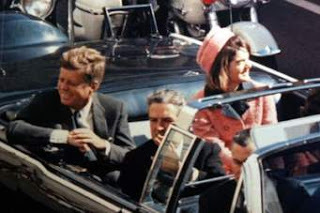
I have just finished a screenplay, inspired by a novel I wrote, that takes place in 1963.
1963 was a pivotal year in America. In March Betty Friedan published The Feminine Mystique. In August Martin Luther King gave his “I have a dream” speech at the March on Washington. And in November, the president, John Fitzgerald Kennedy, was assassinated. Two days later, millions of Americans, glued to their TV sets, watched Jack Ruby, a nightclub owner, shoot and kill JFK's alleged assassin, Lee Harvey Oswald.
Violence had entered the American living room.
Newscasters, including Walter Cronkite, were visibly emotional. People all over the world were shown, weeping and stunned with grief. Frank McGee said on TV: "This is a moment that will be emblazoned in your memory and you will never forget it... as long as you live."
It changed the path of our country, and also the journey of TV news coverage. Images were indelibly branded in viewers' minds: the convertible procession through Dallas... Jackie's pink pillbox hat and pink suit... the smiling, handsome President suddenly crumpling in the seat of the convertible... Jackie refusing to change her bloodstained suit... Lyndon Baines Johnson being sworn in as the new leader... Oswald's smirk in his mug shot... his murder... the State funeral -- Jackie in black, little John-John saluting his father's casket....
Less than a week later, Americans celebrated Thanksgiving in a country, and a world, changing before their eyes and spinning beneath their feet.
People ask me how it felt to write a historical story. The truth is I never felt I was writing a "period piece"—the events I describe still burn with urgency, the words crackling with relevance: racial tension, women's rights, religious intolerance, xenophobia, gentrification. All I had to do was look at today’s headlines to see them reflected in the past. Once, watching a civil rights march on TV, I saw a familiar face. I paused the video: Bernie Sanders protesting racism in 1963.

But 1963 was also the year of Hitchcock's "The Birds" and the musical, "Bye Bye Birdie." Beatlemania was born, and so was the Smiley Face. The first Bond film was released, and eerie Barbie Doll and Ronald McDonald commercials aired on TV.
The thing is I'm not writing about issues -- I'm writing about people trying to figure out what it means to live life as a human being. One of my characters, reeling from the horrors of the Holocaust, only 18 years earlier, says, "To become human is the challenge. It's not enough 'to be' anymore. We have to learn to 'become.' It's the greatest war we have to fight. Against ourselves, first of all. If this war has taught us anything, it's how difficult it is to become a human being."
It's the greatest question we can ask ourselves: What does it mean to become a human being in our world?
In 1963 the seeds were being planted in American soil, all the 'isms and issues that govern, and haunt, our lives today. Imagine if they'd been watered and cherished and allowed to grow free under the sun.
Imagine.
It's not too late to become human.
Published on June 14, 2016 05:00
May 18, 2016
Living in Two Countries
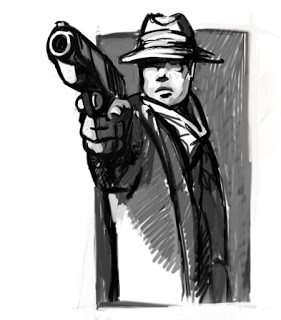
 After all everybody, that is, everybody who writes is interested in living inside themselves in order to tell what is inside themselves. That is why writers have to have two countries, the one where they belong and the one in which they live really. – Gertrude SteinI murdered CG. I did it yesterday morning: after coffee, before breakfast. I can't kill on a full stomach. Does strange things to my digestion. Problem is I'm rusty, haven't murdered anyone in years, and now I'm faced with all sorts of problems. Not guilt. She asked for it. No, it's the body! I have to get rid of the body without... Who is that man? Why is he watching me? What? What do you want?No, I can't eat yet, thanks... I'll go to the market later. Milk, eggs, bread, okay. He's coming toward me. He can't have seen anything. Don't fall apart. You did nothing wrong. You did what had to be done to save...Cheese with peppers, the kind you like. I know. I have to make an appointment with the doctor, too.... They're coming tomorrow, I'll clear up tonight after...After I dispose of the body. And get rid of this man approaching. Okay, freeze, everyone. You mister, stay there. Hold that thought. The supermarket is supernaturally bright. So many suspicious people milling around the produce...It's him! He must have followed me. How is that possible? I don't know, but it's him. The same deranged light in his eyes. He jams the cart and blocks the bananas, allowing no one else near. Entitled, knowing more than he should, daring anyone else to reach for a banana...Now he's moving toward the... grapes. From a safe distance I watch. He reaches in a plastic bag, grabs a handful of red grapes and gulps them down, all at once. Shameless, without pleasure. He looks around furtively. Sneers. The mad light in his eyes. "They're not ripe yet."His voice is strangely high-pitched, creepy, in such a big man. And his words: They're not ripe yet. They're not ripe yet. Oh my God, of course not. They're not ripe yet. The girls. The pretty girls. He knows what I've done. He's saying I acted too soon. I should have waited.But I had to silence her. The questions she was asking would have led right back to...Yes, but now they'll have more questions about what happened to her. And once they start digging, they won't stop till they get to the heart.He's at the Bread aisle. He turns back. One look. And a nod. To let me know he knows.I'm getting out of here. No, I don't have coupons. Yes, I'll give a dollar for the fund.I forgot the eggs, the milk, the bread...Hi! I didn't see you. Yes, I'm fine. No, I haven't seen Ann. Definitely, we'll get together soon. Bye!Why did she ask me about Ann? Does she think I've done something to her? It's true that someone else needs to notice CG is missing. Not just the mad-eyed man. My phone. Hi, sweetie. Yeah, I'm good. Just leaving the market. How are you? Really? That's great. Listen, I have a question. If someone said to you, "They're not ripe yet," would you take that as a warning...?Tossing and turning all night, moving my people around, a dream in which we're all crammed in a supermarket, moving our carts, eying each other with suspicion, and he's there, of course, moving toward me with deadly threat....I return to my people this morning. After (black) coffee... Ah, here they are, frozen as I left them. CG, dead. Banana Man watching. A new person, a woman, enters. "Have you seen...?"Wait. No. I've got it. CG, get up. A brief reprieve. You're not ripe yet. There's one more thing you need to do before...I know I forgot the milk and eggs, but I bought bananas.... They're not ripe either?They never are, he says, his mad eyes focused not on CG, but on me. I'm coming, I'm coming, just give me one more minute....You, that's right, all of you, including you, CG, just wait right there. I'll be back tomorrow.
After all everybody, that is, everybody who writes is interested in living inside themselves in order to tell what is inside themselves. That is why writers have to have two countries, the one where they belong and the one in which they live really. – Gertrude SteinI murdered CG. I did it yesterday morning: after coffee, before breakfast. I can't kill on a full stomach. Does strange things to my digestion. Problem is I'm rusty, haven't murdered anyone in years, and now I'm faced with all sorts of problems. Not guilt. She asked for it. No, it's the body! I have to get rid of the body without... Who is that man? Why is he watching me? What? What do you want?No, I can't eat yet, thanks... I'll go to the market later. Milk, eggs, bread, okay. He's coming toward me. He can't have seen anything. Don't fall apart. You did nothing wrong. You did what had to be done to save...Cheese with peppers, the kind you like. I know. I have to make an appointment with the doctor, too.... They're coming tomorrow, I'll clear up tonight after...After I dispose of the body. And get rid of this man approaching. Okay, freeze, everyone. You mister, stay there. Hold that thought. The supermarket is supernaturally bright. So many suspicious people milling around the produce...It's him! He must have followed me. How is that possible? I don't know, but it's him. The same deranged light in his eyes. He jams the cart and blocks the bananas, allowing no one else near. Entitled, knowing more than he should, daring anyone else to reach for a banana...Now he's moving toward the... grapes. From a safe distance I watch. He reaches in a plastic bag, grabs a handful of red grapes and gulps them down, all at once. Shameless, without pleasure. He looks around furtively. Sneers. The mad light in his eyes. "They're not ripe yet."His voice is strangely high-pitched, creepy, in such a big man. And his words: They're not ripe yet. They're not ripe yet. Oh my God, of course not. They're not ripe yet. The girls. The pretty girls. He knows what I've done. He's saying I acted too soon. I should have waited.But I had to silence her. The questions she was asking would have led right back to...Yes, but now they'll have more questions about what happened to her. And once they start digging, they won't stop till they get to the heart.He's at the Bread aisle. He turns back. One look. And a nod. To let me know he knows.I'm getting out of here. No, I don't have coupons. Yes, I'll give a dollar for the fund.I forgot the eggs, the milk, the bread...Hi! I didn't see you. Yes, I'm fine. No, I haven't seen Ann. Definitely, we'll get together soon. Bye!Why did she ask me about Ann? Does she think I've done something to her? It's true that someone else needs to notice CG is missing. Not just the mad-eyed man. My phone. Hi, sweetie. Yeah, I'm good. Just leaving the market. How are you? Really? That's great. Listen, I have a question. If someone said to you, "They're not ripe yet," would you take that as a warning...?Tossing and turning all night, moving my people around, a dream in which we're all crammed in a supermarket, moving our carts, eying each other with suspicion, and he's there, of course, moving toward me with deadly threat....I return to my people this morning. After (black) coffee... Ah, here they are, frozen as I left them. CG, dead. Banana Man watching. A new person, a woman, enters. "Have you seen...?"Wait. No. I've got it. CG, get up. A brief reprieve. You're not ripe yet. There's one more thing you need to do before...I know I forgot the milk and eggs, but I bought bananas.... They're not ripe either?They never are, he says, his mad eyes focused not on CG, but on me. I'm coming, I'm coming, just give me one more minute....You, that's right, all of you, including you, CG, just wait right there. I'll be back tomorrow.
Published on May 18, 2016 05:42
June 29, 2015
Celebrating Love
 Lovers in St. Petersburg
Lovers in St. Petersburg
Some of you may remember that when I set out on my voyage last August, I decided to use "love" as the focus of my blog posts and explorations of the world. The idea came to me in London, when I walked along the Thames and saw an exhibit celebrating love in all its forms and inviting the passerby to enter the "tunnel of love."
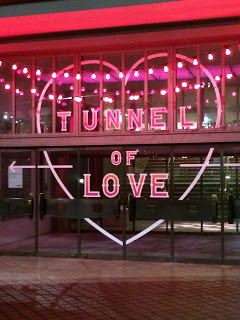
I've never not been fascinated, even obsessed, by the question of love. Like many girls, I wanted to be Nancy Drew, but with one caveat: I wanted to be a love detective--to seek out the mysteries, secrets, wonders of love. I snooped and spied on everyone, strangers and friends, trying to get to the heart of what I considered the greatest mystery of all: why do we fall in love with one person, and not another?
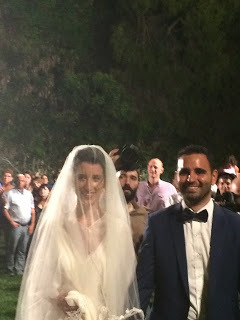
I read romance comics--anyone remember those hoary, moralistic tales?--and devoured love stories wherever and however I found them. I wrote my first love story at age 14 and proudly handed it in to my English teacher. It was a terrible imitation of Colette and D.H. Lawrence (did I mention I was a very precocious reader?), a sensual realization by a woman that her lover has left her and will never return. The woman breathes in their sheets and pillows, still smelling of their lovemaking, and she knows she will never forget his unique scent and the love they shared. Keep in mind this was written by a girl who had been kissed a couple of times, but who gleaned her knowledge by following people, staring at them and eavesdropping on conversations, and of course imagining what exactly Lady Chatterly and her lover did without having a clear sense of the depths and heights, and even the humor, of passion. All I knew was there was a world out there I needed to explore.
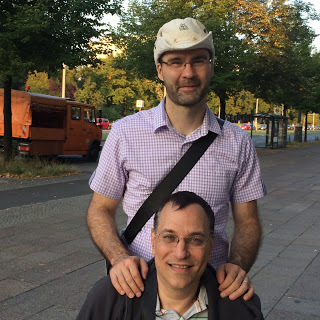
The teacher ripped it to shreds in front of the entire class. She called my writing, "obscene," a word I'd never heard of before. After that, years passed before I shared my writing again.
Today I may have a clearer sense of the realities of love, but I'm still every bit as curious (my husband says, "nosy") as when I was a kid and picked up The Royal Road to Romance by Richard Halliburton, an early 20th century traveler and adventurer, simply because of its title. Little did I know it was the beginning of the merging of my two great passions: love and travel. I'm not searching for definitive answers anymore: there is no one true solution to the mystery of what is love or who we love. And there is no one voyage that will tell me: this is it, the final border, no more to see, nothing left to explore. There will always be more. Many great travelers have said that we travel in order to understand the landscape of ourselves. Love, like travel, teaches us to see with all our senses. It is a promise and a gift.
I believe love is the most profound form of travel: it teaches us to explore another human being with the same curiosity, humility, wonder and compassion with which we explore a foreign country. And to return to ourselves, hopefully, with a new generosity and tenderness. As we approach the 4th of July, our day of independence, let's celebrate the freedom to love and marry whom we choose. Happy Freedom Day, everyone!
Published on June 29, 2015 08:25
March 19, 2015
Entering the Woods

“No dawdling or daydreaming,” warned the mother of a school friend. “Go directly to school and come directly back home.”
Her words filled me with horror. To walk back and forth from school and not stop to notice the cornstalks bursting through sheets of ice. Not stand beneath a tree and puzzle at the cottony gray veils spreading between branches—a witch’s shawl, I thought, but later learned it was deadly gypsy moths. Not crouch over a brass key found on the sidewalk, and shiver, knowing it was a clue dropped by a spy who was watching right now to see who dared pick it up.
Every day was an adventure, a treasure hunt crammed with mysterious characters and wondrous sights, and how on earth could I get to the heart of the world if I didn’t dawdle, daydream, and step off the path? At nine, I already knew I’d be a writer and accepted my destiny: to always be late, to go off the clearly marked, brightly lit path, and to make it to my destination via the most winding route imaginable.
Today, I see my friend’s mother’s warnings echoed and transformed into time management software, templates and graphs offering shortcuts that speed you through the creative process. No pain. No wasted minutes. No blundering in the dark. Someone has already mapped your journey for you and connected the dots.
It may not be fair, but I kind of blame Little Red Riding Hood’s mother for our obsession with speeding to our destination while ignoring the by-paths that tempt along the way. Go directly to Grandma’s house, she said. Don’t go off the path or talk to the Wolf.
Even as a kid, I loathed this tale and its cheerless message: Complete your mission and do not stop to smell the flowers or acknowledge the danger that lurks at the side of the road.
It’s often tempting when we start a creative endeavor to follow the safe, clearly marked path. Others have gone before you and left behind signs and guideposts. You won’t get lost on that path, and you may get to Grandma’s house in record time, like the White Rabbit in Alice in Wonderland, looking at his watch and muttering, Hurry, hurry, there’s no time to waste.

The forest of tall, narrow birch trees outside St. Petersburg—trees like guards hiding secrets, maybe fairy tale monsters.
But you know what? I’m here to tell you that if you want to truly create a book, song, painting or magic illusion from your soul, you need to step off the bright-lit road and explore the deep dark woods. The roads are not marked. No dots are connected, and you have to hack your way through in order to create a path no one else has ever walked. Strange sounds accompany you, unknown creatures howl, and vines wind around you. You will be alone for a while. You will get lost. You will get scared. And you’ll hear the sound of your own voice crying out in the wilderness. It may seem the sun will never rise again and you’ll be lost forever.
That’s the time to gather your strength and courage for a final effort. Our ancestors, who told fairy tales around a fire at night or in a kitchen, understood one of the primary messages of the tales: a character must undergo a sea-change, dramatic and profound, in order to become the hero or heroine they are meant to be. Entering the woods—whatever form they take—is like entering the deepest, darkest part of yourself. If you write, your characters need to undertake this journey as well as you do. If you brave the woods and face the dark terrors that haunt you—your personal Wolf—you will glimpse light at the end of that long night.
And when you finally emerge from the woods, you may find yourself at Grandma’s house after all.
Or a castle on a mountain.
Or ancient ruins by the sea.
Or your own backyard where it may appear you’ve been doing nothing but lying on the grass, while in reality you conquered dragons, saved (and taken) lives, discovered the cure to a dangerous virus, touched a star.
I confess that my favorite versions of Red are the ones in which she does it all: picks flowers, chats up the Wolf and gets his measure, and makes it to Grandma’s where she outwits him, and in the process manages to clear the woods of that dangerous beast. All in a day’s work. And then she, Grandma and the Huntsman settle down for tea and cookies. Now that’s a story that warms my heart.
Two roads diverged in a wood, and I,
I took the one less traveled by,
And that has made all the difference.
--Robert Frost, The Road Not Taken
A note: In case you wonder, I do own a watch. Several months ago, in preparation for a three and a half month sea voyage spanning three continents, I bought a large, complicated watch that looked like it could do everything but navigate the ship. Sadly, it was so complicated I never could figure out how to change the time in each new port. Neither could anyone else. I’ve since taken it off and set it on my bedside table. I feel much more relaxed though it emits resentful beeps at unspecified times (5:39, 7:53) that remind me of my friend’s mother. Dire warnings, I’m sure, which I’m happy to ignore.
Published on March 19, 2015 04:29
January 8, 2015
Ruth's Tao of Travel
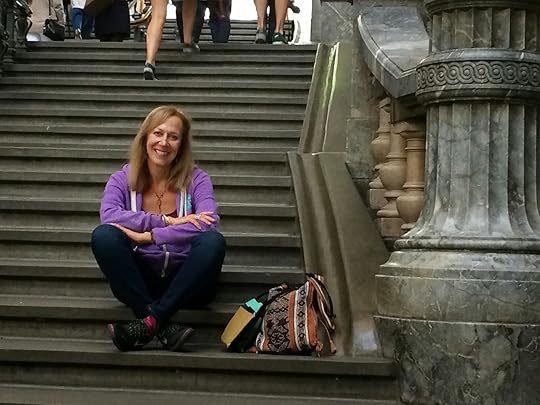 Antwerp Train Station
Antwerp Train StationJanuary 8, 2015
One month ago today I climbed down the gangway of the MV Explorer for the last time and set foot on land in the USA after four months away. During that time I traveled to 14 countries, a whirl of impressions and experiences that still dizzies, enchants and excites me.
I had many first experiences, including raking and harvesting salt (Cadiz), learning to create a stencil portrait with a graffiti street artist (Berlin), making delicious tapas (Barcelona), dancing salsa in a nightclub (Havana), studying percussion at a samba school (Rio de Janeiro), communing with a goddess (Kildare, Ireland), and attending a candomble ceremony (Salvador).
I tasted new foods, listened to live music of all kinds, danced my heart out, and talked to people with every language in my power-- words, gestures, smiles.
I asked myself and my fellow travelers questions: Why do we travel? To see the destination? To learn about the place? To search for truths about ourselves?
I realized that I travel to connect -- to connect with gods, myths and people through food, music and history. Even more, to find the myths, foods, songs and stories that connect us rather than divide us.
To that end, I've compiled a list of 10 travel guidelines, a Tao of Travel inspired by the great traveler, Paul Theroux. In homage, my #1 is the same as his. I hope they inspire you to create your own list ... and to take off on a trip yourself. Happy Voyages in 2015!
1. Travel alone. At the very least, find time to be alone-- an hour, an afternoon-- and explore on your own. Walk whenever you can.
2. Get lost. Seriously. Remember the art of wandering. Take a bus, subway or walk with no destination, and then gradually wind your way back to where you began. Be sure to ask directions and talk to people along the way.
3. Eat where locals do.
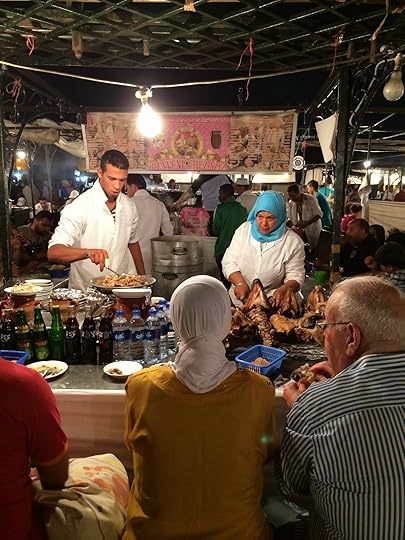 Outdoor stand in the Djma el Fna'a, Marrakesh
Outdoor stand in the Djma el Fna'a, Marrakesh
4. Browse a street market or supermarket. You can learn so much from the items that are (or are not) stocked. The empty shelves in St. Petersburg and Havana, the enticing windows and bursting produce in Barcelona and Naples ....
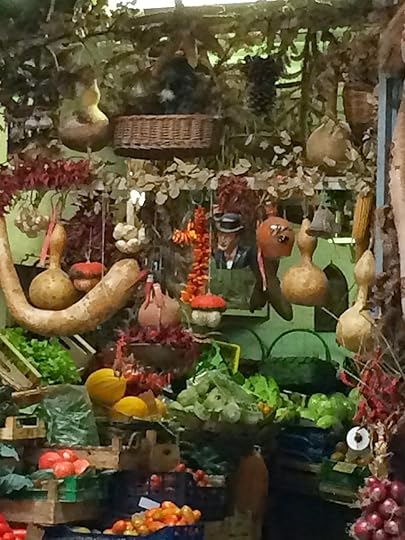 Storefront in Naples
Storefront in Naples La Boqueria, Barcelona
La Boqueria, Barcelona5. Keep a travel journal. You will never have a second chance to have a first impression of a place. Write it down while the sensory details are fresh in your mind.
6. Do something touristy. Splurge once, if you can.
7. Connect. Talk to people. Ask questions. Not just fellow tourists, but guides-- they are proud of their city or country and want to share it-- and locals. Ask them where to go and what to do.
8. Pre-voyage: learn basic phrases for each new country. Read a bit of poetry, fiction, and nonfiction by noted authors of the country.
9. Stop journaling and photographing. (I know, I know, but you need to look up and see directly with your eyes, too.) Sit for an hour on a bench or at a cafe and watch people. Listen to them. Absorb their rhythm.
10. When we travel, we take home impressions, souvenirs, memories. But what do we leave behind? Did we connect with anyone who will remember us? Traveling gives us the chance to leave a part of ourselves everywhere we go, not only to be touched by others, but also to touch other lives.
Below, some of the wonderful people who helped make my voyage unforgettable. Thank you! Gracias! Danke! Obrigada! Until we meet again ....
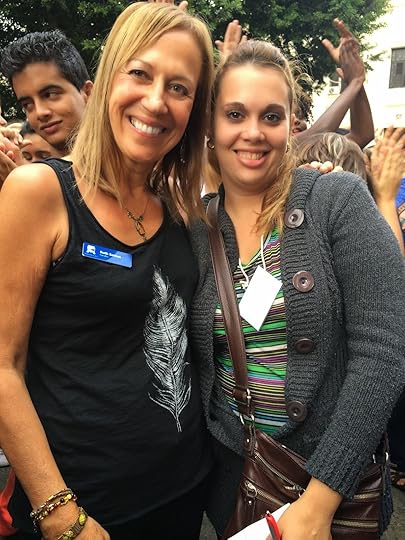
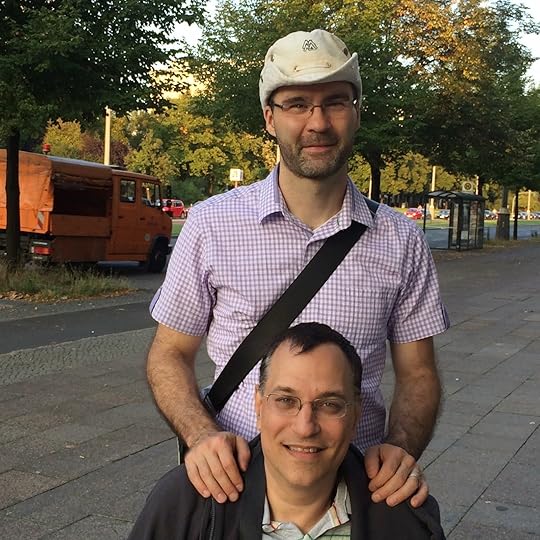
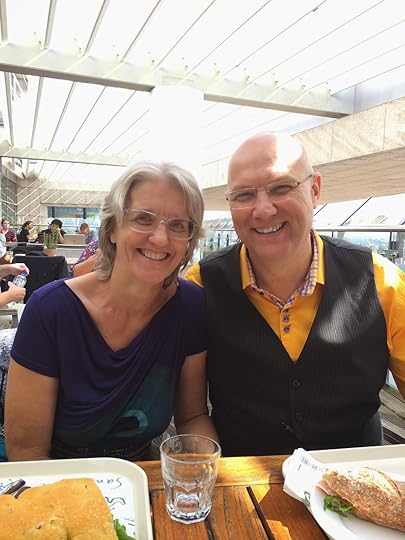


Published on January 08, 2015 09:22
December 19, 2014
Cuba: Myth & Reality
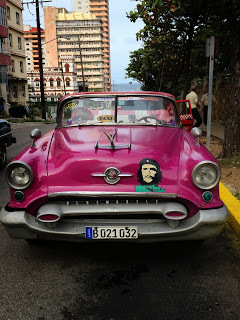
I wrote this post last week, a few days before US agreed to normalize relations with Cuba and to free the remaining members of the Cuban 5. Doors between the US and Cuba that have been closed for over 50 years are now opening. Hard to believe I was in Cuba a few short weeks ago. The excitement was palpable, we felt a change in the air, fresh winds blowing from the sea ....
Day 1, and a dozen photographers snapped our photos as we descended the gangway of the MV Explorer, our home for past 108 days, giving us our first taste of paparazzi. A police escort accompanied us from the port to the university, where the rector of the university urged peace between the US and Cuba.
This is my third Semester at Sea voyage as a faculty member teaching Travel Writing and Creative Writing, and I’ve left pieces of my heart in many cities around the world, but this heartfelt welcome to Havana brings me to tears, nearly making me miss the enormous banner draped over the entrance to the university: The Cuban 5.
“Imagine there’s no heaven,” sings John Lennon over the loudspeaker. “It’s easy if you try.” I am known for my imagination, but nothing prepared me for this surreal moment: over six hundred Semester at Sea students, faculty and staff climbing the eighty-eight steps to the University of Havana on a windy morning in late November. Later, I get lost in the rhythm of the dance as Cuban and American students (and faculty!) move to the beat.
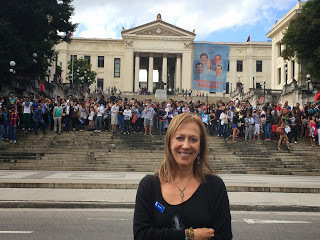
The most problematic moment of the day comes when we file into a small theatre in Vieja Havana where La Colmenita (The Little Beehive) a children’s theatre group (aged five to fourteen) will put on a special performance for us. “In English, just for you,” cries Tim, the gray-mustached manager/director of the troupe. “With love for you! Enjoy!” He blows us kisses, and the curtain goes up. I settle in my chair and watch the children perform a play. They are talented and adorable, especially a tiny girl wearing large glasses, and dressed in a jaunty Peter Pan cap and tights. But wait … what’s this? In the middle of the play, a public service announcement with Danny Glover exhorting us to free the Cuban 5? And video footage of the 5 tenderly playing with their children or teasing their mothers? Ah, I see, this isn’t a play at all. It’s propaganda masquerading as art, slogans pretending to be dialogue—uttered by wide-eyed, earnest children. My stomach coils tighter than when the ship sailed through a typhoon. You’re in Cuba, I remind myself. Did you expect a frothy Disney concoction with singing, dancing little bees? Yes, I admit. I want to see Cuba as more than politics and myths of revolution. It’s a tropical paradise of faded glamour, mojitos and daiquiris, hot salsa that starts in the soul and travels to the feet, and warm, generous people. It is also a country where time seems to have stopped in 1959, at the height of revolucion. A country of old men: Che Guevara, Fidel Castro, and Ernest Hemingway, a Holy Triad who never age and remain frozen in myths as colorful as the 50s cars sailing down the roads, and whose photos loom over the entire city.
Tour historic Hotel Nacional with Estela, the diminutive guide who was eighteen during the Cuban Missile Crisis, and move from notorious Room 214—where Frank Sinatra stayed and used the secret entrance to Meyer Lansky’s room—to the underground bunker where posters display photos of Fidel Castro with Khrushchev. “This is my Fidel,” sighs Estela. “I wish they showed these pictures of him all over town, not the ones when he got older.” But no one sees the eighty-eight year-old ailing former leader. The images of Fidel plastered around Havana depict a rumpled, bearded middle-aged man. Fidel hasn’t aged, and neither has the second member of the Bearded Triumvirate dominating Havana’s mythic landscape: Che Guevara, handsome and charismatic from fierce glare to clenched jaw. Che’s face—the iconic portrait that inspired the hippie revolutionary movement of the late 60s-early 70s—broods from book covers, posters, T-shirts, key chains, ashtrays, and aprons, and at night, lights up against a building overlooking the Plaza de la Revolucion. Though I haven’t smelled the Che Guevara cologne, I’ve been assured it exists. A Cuban friend told me that after Cuba, Che went to Bolivia to offer his services, but when the Bolivians saw Che in reality—balding, wearing glasses, middle-aged paunch—they turned him down. The third member of the Holy Triad, Ernest Hemingway, still bursts with testosterone from black and white photos where he grips a shotgun or fish, drinks at his favorite bars, smiles with Fidel, and poses with his hunting trophies. Tour buses unload Hemingway aficionados in Cojimar, the wild, isolated fishing village that inspired The Old Man and the Sea. At his favorite seaside café, La Terraza, they are given fizzy blue drinks (specialty of the house) and led to the dining room to ogle his table, roped off and set and waiting. Back in Vieja Havana, I walk into the room in the pink Hotel Ambos Mundos, where he lived ($3/night during the low season, $5 high season) and wrote. And drank and lived hard. Peering over his typewriter (under glass), I picture him writing terse, taut sentences, tossing adjectives and adverbs out the window like small wriggling fish. Around the corner at La Bodegita del Medio, a cozy neighborhood bar that serves up mojitos, cigars, and hot music, I toast him with a mojito, and then follow his shadow down the pedestrian street of Obispo, lined with cafes, shops, churro stands, and musicians, to the swirling neon sign of El Floridita, the delightfully retro bar known for its daiquiris. I sit next to his smiling bronze bust—on his favorite stool, his back to the wall—and over a daiquiri named for him, I ask what he thinks of this country of old men who remain forever young. He doesn’t answer, maybe because behind us, trapped in his own black and white myth, Fidel eavesdrops.


On my last evening in Havana, I explore the streets beyond the carefully circumscribed tourist areas. The instant you step off Obispo and Mercederes, you stumble into enormous potholes and torn-up roads, crumbling buildings, markets with nearly empty shelves, and people talking, smoking, eating, and laughing on balconies and steps. They rarely eat at the tourist restaurants a few blocks away. There are two different currencies—one for the tourists (Cuban Convertible Pesos, or CUCs), and one for the Cubans (pesos). US dollars are not officially supposed to be exchanged, but for ten US dollars, you get eight CUCs. The average monthly salary for a doctor is fifteen CUCs. A daiquiri at El Floridita costs six CUCs. Health care and education are taken care of, but it is incredibly difficult to live, day to day. When I ask a Cuban friend how he survives on a monthly salary of thirteen CUCs, he shrugs. “Black market. Extra jobs. Tips.” Then, with a shy grin, “Do you have room for one Cuban on your ship?”
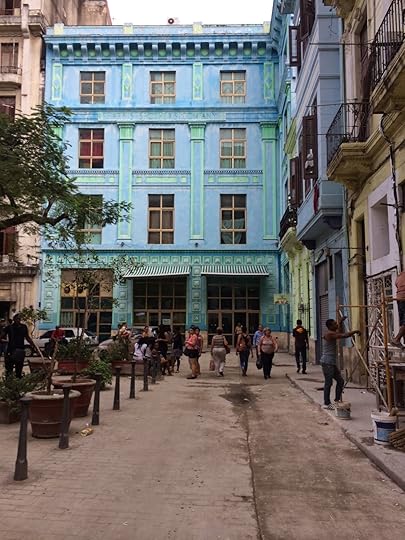
As the sky darkens, I return to the port along the Malecon, a five-mile walkway along the sea. In the distance I glimpse the lights of our ship, the MV Explorer. Havana is our last port, and in less than a week we’ll return home to the United States. I’ve fallen in love with this city—the tropical promise and warmth, and even the underlying shadows beneath every ray of sun. I understand that people eat myths for survival, but the revolucion was fifty-five years ago, Che was executed, Fidel has a successor, and two of the Cuban 5 are home. I wrote these words as soon as we returned to the US. Now, in light of new developments from Washington, I hear the clock ticking again. It’s time to move on and imagine new stories, ones that haven’t been written because they haven’t been lived yet. To create new heroes. To restore hope. As John Lennon says, “Imagine all the people living in peace …. You may say I’m a dreamer, but I’m not the only one.”
 Dancing at the University of Havana
Dancing at the University of Havana
Published on December 19, 2014 07:47
November 28, 2014
Barbados: Girls on the Island
Rihanna is on the island.
"You might see her," says Mike, the cabdriver we hired to show us around the island. Our tour begins with the small white bungalow on Parris Street in Bridgetown where Rihanna lived until Jay-Z discovered her and she became a global superstar. We sit in the taxi in front of her house while Mike explains that she now has a number of condos, hotel suites and houses to choose from. "But she's a normal girl," he says approvingly. "Doesn't stick her nose in the air. She goes to Sugar's at night to dance and drives around in a buggy. She knows she's home on the island."
A beautiful place to call home, this lush island where rum flows, white sand trickles between your fingers, and the Atlantic and Caribbean meet, and everything tourist-related is expensive. Many wealthy ex-pats own mansions in gorgeous gated communities, mostly in St. James Parish, north of Bridgetown. Thinking about relocating? You might be neighbors with Tony Blair, Tom Selleck, Cliff Richard, Cilla Black, and many others. Oh, and the omnipresent Oprah has a mansion here as well. I say "omnipresent" because nearly everywhere I've gone during this voyage, a local has informed me that Oprah has a house there... though she's never seen, just helicoptered in and out like a mythical goddess. I think it's safe to say that she is not a normal girl on the island.
"There is no middle class in Barbados," says Mike in the Barbadian accent, which merges Cockney with high British and island drawl. "Only rich and poor. But every beach is free. That's the law."
We take us on a whirlwind tour of the island, including stops at St. Nicholas Abbey-- a former sugar plantation where rum is made, bottled and sold-- and rugged, wild Bathsheba Beach on the east Atlantic coast where surfers come to ride the waves.
The following night, following Mike's advice, we head to Holetown, where there is a weekly karaoke street party, and a drag queen show at Ragamuffin's, a small restaurant-bar owned by Neil Patterson, a British ex-pat who has decorated his lovely restaurant with images of the Buddha and paintings from Nepal. Promptly at 9:00, Mannequins in Motion, three drag queens, begin an energetic 90-minute show. The stage is the small area between the bar and the tables, but the performers strut and weave around the waitress and diners. At least six and a half feet tall, the bone-thin leader of the group startles a couple by pushing their plates to the side, climbing on their table, lying back and waving her endless legs in 5-inch heels in the air.
After the show, she and I stand in the doorway of the restaurant and look out at the pouring rain. The karaoke street party has dispersed. With a sigh the Mannequin sets down her enormous pink feathered headdress.
We look from her glittering Dorothy high heels-- the kind a normal girl can make a wish on-- to my flat black sandals, still sand-dusted from an earlier walk on the beach. Our eyes meet, and she gives me a rueful grin.
"From London. Brand-new. Shoes make the girl, you know."
Oh, I know. My trusty sandals have taken me salt-harvesting, wading through seas in Europe and Latin America, up and down steep cobbled streets in North Africa, and dancing in nightclubs and on sand everywhere.
We lean against each other for just a moment-- two girls, with shoes, hanging out on a Sunday night in Holetown.
* I pretend I'm walking on sand as I explore Nidhe Israel Synagogue in Bridgetown-- the first synagogue in the Americas. When the temple was built in 1654, the new Jewish immigrants covered the floor with sand to symbolize the Israelites wandering in the desert for forty years before they came to the Promised Land.
Armed with a valuable knowledge of sugar, this first wave of Jews came from Recife, Brazil, to the Land of Coconut Milk and Sugar Cane, which they hoped to turn into their Land of Milk and Honey. Their stay in Barbados began promisingly as they established and developed sugar plantations. However, this golden period lasted only five years, until 1659, when the Portuguese grew jealous of the Jews' success with sugar. They imposed a law restricting Jews to a single slave, thereby eliminating the possibility of a Jew maintaining a sugar plantation. Hence, the Jews lost the sugar trade. They struggled to survive, and many left for the Carolinas.
In 1750, about 800 Jews remained in Bridgetown. By 1850, the number had dwindled to 71. Today, of the 83 Jews who live in Barbados, a handful are descendants of the original settlers from Recife. Celso Brewster, the genial manager of the small museum adjoining the synagogue, is one of them, and like the other descendants, he is not a Jew.
Between the museum and the synagogue is the cemetery with its fascinating Sephardic carved tombstone designs, including skulls and crossbones, Tree of Life, palms, winged cherubs and doves. A few feet away from the cemetery, stands the stone mikveh (women's ritual bathhouse). It was excavated in 2008, and small Minute Books were found that offer a unique view of women's lives in early Barbados and a history of the Jewish community in Barbados.
The pink synagogue is airy and simple. My friend Ricki and I can't climb the outside steps to the Women's Gallery, but we sense the presence of the women who prayed upstairs and washed nearby in the mikveh. I shake off a sudden image of the Mannequins in Motion, kicking off their sequined heels and dancing across the sandy floor.
Ricki and I head back out to Synagogue Lane and turn down Swan Street, formerly known as Jew Street. The sun is bright, the sea calls, and maybe one last Passionfruit Daquiri to soften the pain of leaving this tropical island. "Jesus is the way!" shouts a man on a radio. The street is crammed with local-owned booths and shops that sell fruits and vegetables, nuts and snacks, and clothing and shoes (though none as high as the Mannequins') and offer services like "Eyebrows cutting and arching."
No eyebrows cutting today. Just two normal Jewish girls in our sandals, trudging across the sand to the next stop in our wanderings.
"You might see her," says Mike, the cabdriver we hired to show us around the island. Our tour begins with the small white bungalow on Parris Street in Bridgetown where Rihanna lived until Jay-Z discovered her and she became a global superstar. We sit in the taxi in front of her house while Mike explains that she now has a number of condos, hotel suites and houses to choose from. "But she's a normal girl," he says approvingly. "Doesn't stick her nose in the air. She goes to Sugar's at night to dance and drives around in a buggy. She knows she's home on the island."
A beautiful place to call home, this lush island where rum flows, white sand trickles between your fingers, and the Atlantic and Caribbean meet, and everything tourist-related is expensive. Many wealthy ex-pats own mansions in gorgeous gated communities, mostly in St. James Parish, north of Bridgetown. Thinking about relocating? You might be neighbors with Tony Blair, Tom Selleck, Cliff Richard, Cilla Black, and many others. Oh, and the omnipresent Oprah has a mansion here as well. I say "omnipresent" because nearly everywhere I've gone during this voyage, a local has informed me that Oprah has a house there... though she's never seen, just helicoptered in and out like a mythical goddess. I think it's safe to say that she is not a normal girl on the island.
"There is no middle class in Barbados," says Mike in the Barbadian accent, which merges Cockney with high British and island drawl. "Only rich and poor. But every beach is free. That's the law."
We take us on a whirlwind tour of the island, including stops at St. Nicholas Abbey-- a former sugar plantation where rum is made, bottled and sold-- and rugged, wild Bathsheba Beach on the east Atlantic coast where surfers come to ride the waves.
The following night, following Mike's advice, we head to Holetown, where there is a weekly karaoke street party, and a drag queen show at Ragamuffin's, a small restaurant-bar owned by Neil Patterson, a British ex-pat who has decorated his lovely restaurant with images of the Buddha and paintings from Nepal. Promptly at 9:00, Mannequins in Motion, three drag queens, begin an energetic 90-minute show. The stage is the small area between the bar and the tables, but the performers strut and weave around the waitress and diners. At least six and a half feet tall, the bone-thin leader of the group startles a couple by pushing their plates to the side, climbing on their table, lying back and waving her endless legs in 5-inch heels in the air.
After the show, she and I stand in the doorway of the restaurant and look out at the pouring rain. The karaoke street party has dispersed. With a sigh the Mannequin sets down her enormous pink feathered headdress.
We look from her glittering Dorothy high heels-- the kind a normal girl can make a wish on-- to my flat black sandals, still sand-dusted from an earlier walk on the beach. Our eyes meet, and she gives me a rueful grin.
"From London. Brand-new. Shoes make the girl, you know."
Oh, I know. My trusty sandals have taken me salt-harvesting, wading through seas in Europe and Latin America, up and down steep cobbled streets in North Africa, and dancing in nightclubs and on sand everywhere.
We lean against each other for just a moment-- two girls, with shoes, hanging out on a Sunday night in Holetown.
* I pretend I'm walking on sand as I explore Nidhe Israel Synagogue in Bridgetown-- the first synagogue in the Americas. When the temple was built in 1654, the new Jewish immigrants covered the floor with sand to symbolize the Israelites wandering in the desert for forty years before they came to the Promised Land.
Armed with a valuable knowledge of sugar, this first wave of Jews came from Recife, Brazil, to the Land of Coconut Milk and Sugar Cane, which they hoped to turn into their Land of Milk and Honey. Their stay in Barbados began promisingly as they established and developed sugar plantations. However, this golden period lasted only five years, until 1659, when the Portuguese grew jealous of the Jews' success with sugar. They imposed a law restricting Jews to a single slave, thereby eliminating the possibility of a Jew maintaining a sugar plantation. Hence, the Jews lost the sugar trade. They struggled to survive, and many left for the Carolinas.
In 1750, about 800 Jews remained in Bridgetown. By 1850, the number had dwindled to 71. Today, of the 83 Jews who live in Barbados, a handful are descendants of the original settlers from Recife. Celso Brewster, the genial manager of the small museum adjoining the synagogue, is one of them, and like the other descendants, he is not a Jew.
Between the museum and the synagogue is the cemetery with its fascinating Sephardic carved tombstone designs, including skulls and crossbones, Tree of Life, palms, winged cherubs and doves. A few feet away from the cemetery, stands the stone mikveh (women's ritual bathhouse). It was excavated in 2008, and small Minute Books were found that offer a unique view of women's lives in early Barbados and a history of the Jewish community in Barbados.
The pink synagogue is airy and simple. My friend Ricki and I can't climb the outside steps to the Women's Gallery, but we sense the presence of the women who prayed upstairs and washed nearby in the mikveh. I shake off a sudden image of the Mannequins in Motion, kicking off their sequined heels and dancing across the sandy floor.
Ricki and I head back out to Synagogue Lane and turn down Swan Street, formerly known as Jew Street. The sun is bright, the sea calls, and maybe one last Passionfruit Daquiri to soften the pain of leaving this tropical island. "Jesus is the way!" shouts a man on a radio. The street is crammed with local-owned booths and shops that sell fruits and vegetables, nuts and snacks, and clothing and shoes (though none as high as the Mannequins') and offer services like "Eyebrows cutting and arching."
No eyebrows cutting today. Just two normal Jewish girls in our sandals, trudging across the sand to the next stop in our wanderings.
Published on November 28, 2014 16:12



